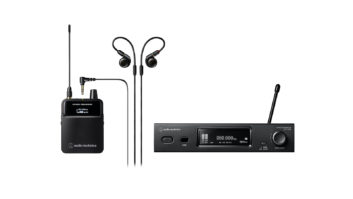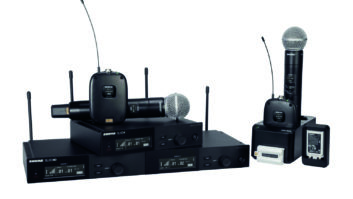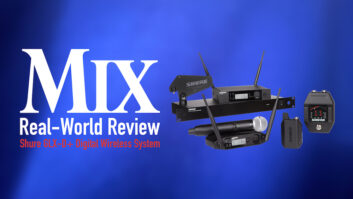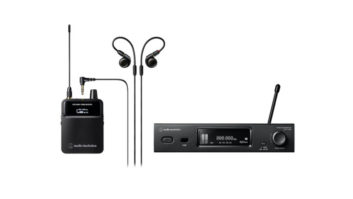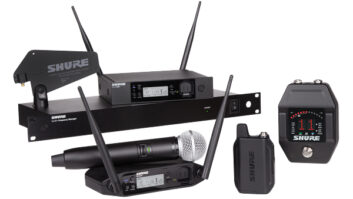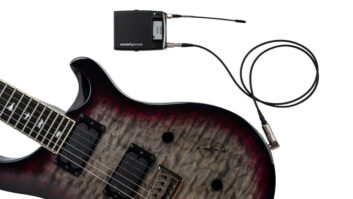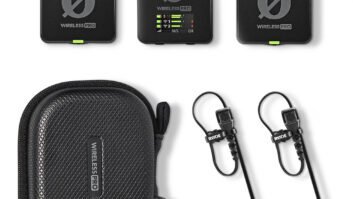The proliferation of wireless systems is a blessing for contractors, virtually ensuring that the right combination of price, features and performance can be found for any given job. It occurs to me there is another benefit as well. Now that most microphone manufacturers offer wireless systems, one can be reasonably certain of matching vocalists with their preferred mic.
The 7000 Series wireless systems are available as the ATW-7376 handheld system ($995), which includes an ATW-R73 receiver and an ATW-T76 handheld transmitter; or as the ATW-7375 bodypack system ($975). The bodypack system includes an ATW-R73 receiver and an ATW-T75 UniPak. I tested the ATW-R73 half-rack receiver, ATW-T76HE dynamic microphone with transmitter, ATW-T75 bodypack transmitter and AT831-CW miniature cardioid condenser mic.
Features/In Use
The 7000 Series is compatible with a broad range of optional Audio-Technica mics and includes other accessories, such as mounting hardware and a kit for front-mounting antennas. There is also an optional antenna distribution kit that connects four receivers to one pair of antennas.
The ATW-R73 is a frequency-agile true-diversity UHF receiver, with 100 user-selectable frequencies from 728.125 MHz to 740.5 MHz. The ATW-R73 contains two receivers and monitoring circuitry that automatically switches to the tuner receiving the strongest signal from the microphone or bodypack transmitter. The receiver’s front panel contains the power on/off switch, an LED display indicating the current channel setting, channel selector switches, RF signal and AF level indicators, LEDs to indicate which receiver is active and an output level control.
The back panel provides BNC connectors for the A and B antennas, a squelch control, an XLRM jack for balanced output and 1/4″ jack for unbalanced output, a ground-lift switch, an input for 12 to 18 V DC and an AC power cord. In particular, with the balanced and unbalanced outputs, the signal from the receiver can be fed to both the console and a backline amplifier.
Both the ATW-T75 bodypack transmitter and the ATW-T76HE microphone draw 50 mA of current and require one 9 V alkaline battery, which provides 8 to 10 hours of operation. Channel selection controls for the bodypack are located in the battery compartment, as are microphone and instrument trimmers. The on-off/standby switch, battery indicator, input connector and antenna are on the bottom of the bodypack.
The microphone has slotted-head channel selector switches on the barrel, opposite the battery compartment, beneath a full-length sleeve. A convenient miniature screwdriver clips onto the side of the microphone below the channel controls. Additional controls on the microphone include an on/off switch and a battery condition indicator on the endplate.
Operating frequency is set by selecting a channel — designated from 00 to 99 — at both the transmitter and receiver, with the power off. A table in the operator’s manual lists the frequency of each of the 100 channels and its corresponding UHF TV channel, either 57, 58 or 59. Knowing the latter lets you avoid frequencies that may conflict with local TV transmissions. To set the channel at either the receiver or transmitter, select the decade and the unit using individual switches — for example 50 and 5 respectively, for channel 55. The sheer number of channels should go a long way toward providing interference-free performance, even in media-saturated areas.
The 7000 Series provided a strong, clear signal up to its specified 300’ range, without dropouts or interference. This range of operation makes the system suitable for more demanding applications including large outdoor venues. ATW-T76HE exhibited little handling noise and good off-axis rejection. The AT831cW clip-on microphone was sensitive and clear when worn head- or body-mounted. The system claims a signal-to-noise ratio greater than 100 dB and THD of less than 1%.
Summary
The Audio-Technica 7000 Series is a fully featured professional system. It’s nicely designed and well built, with a metal enclosure and the requisite mounting options for all installations. It provides a large number of channels and accommodates a wide variety of Audio-Technica microphones, as well as high-impedance instrument inputs. Its addition to the roster of available UHF wireless systems gives the contractor another highly versatile option suitable for most installations or sound reinforcement assignments.
Product Points
Applications: Live sound
Key Features: Handheld system; receiver; handheld transmitter; body-pack system
Price: Depends on configuration; $975 as tested
Contact: Audio-Technica at 330-686-2600
Plus
+ Compatible with a range of AT mics and accessories
+ Strong, clear signal
Minus
– None
The Score: The Audio-Technica 7000 Series gives the contractor a highly versatile mic option.
